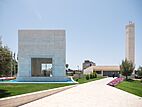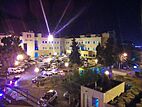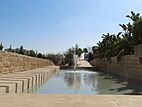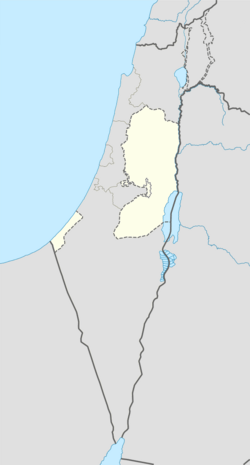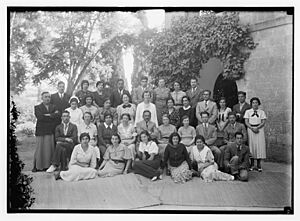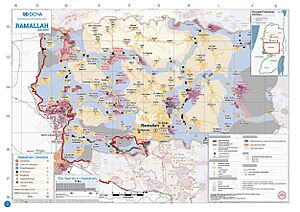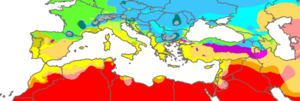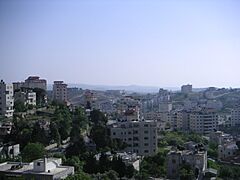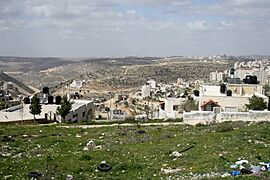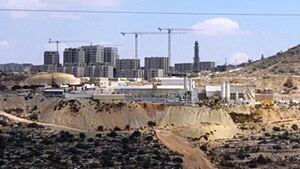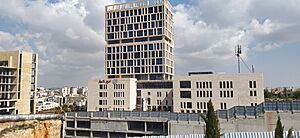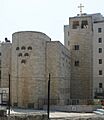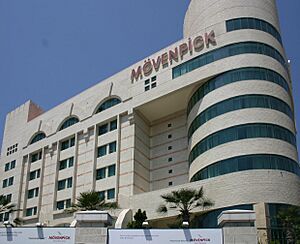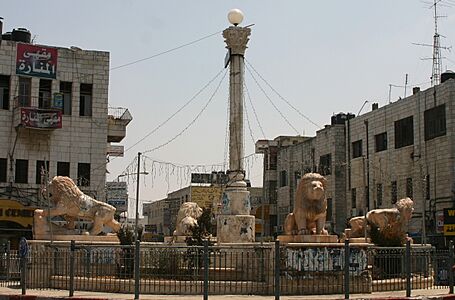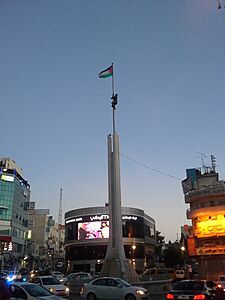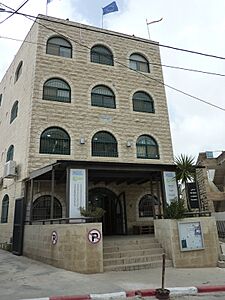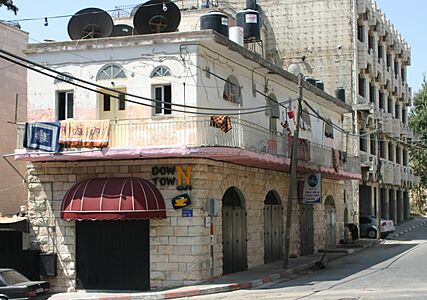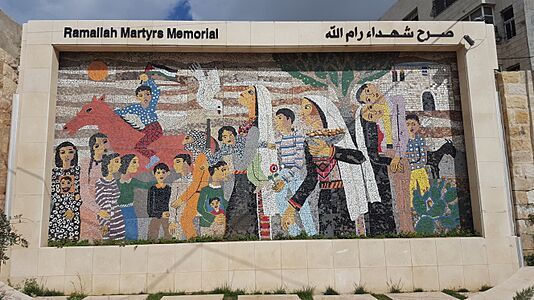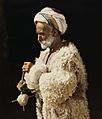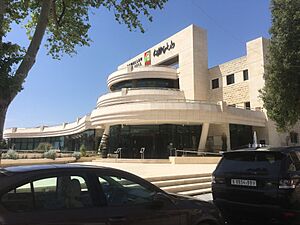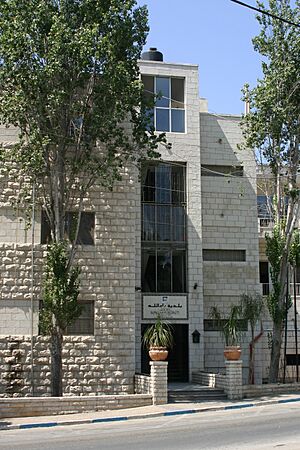Ramallah facts for kids
Quick facts for kids
Ramallah
|
||
|---|---|---|
|
Municipality type A (City)
|
||
| Arabic transcription(s) | ||
| • Arabic | رام الله | |
| Hebrew transcription(s) | ||
| • Hebrew | רמאללה | |
|
Clockwise from top:
Ramallah skyline and the central mosque, Arafat mausoleum, Our Lady of the Annunciation Church, Roman ruins, Al-Manara Square |
||
|
||
| State | State of Palestine | |
| Governorate | Ramallah and al-Bireh | |
| Government | ||
| • Type | City (from 1995) | |
| Area | ||
| • Municipality type A (City) | 16,344 dunams (16.3 km2 or 6.3 sq mi) | |
| Population
(2017)
|
||
| • Municipality type A (City) | 38,998 | |
| • Density | 2,393/km2 (6,197/sq mi) | |
| • Metro | 153,237 (2,002) 362,445 (2,016) |
|
| Website | www.ramallah.ps | |
Ramallah is a city in the central West Bank, a region in Palestine. It's like the unofficial capital of the State of Palestine. The city sits on the Judaean Mountains, about 10 kilometers (6 miles) north of Jerusalem. It's quite high up, around 872 meters (2,861 feet) above sea level.
Ramallah has some very old stone buildings from the time of Herod the Great (a king from long ago). But most of the city as we know it today started in the 1500s. It was founded by a Christian family called the Hadadeens. Over time, Ramallah became part of the Ottoman Empire, then British Mandatory Palestine after World War I. Later, it was controlled by Jordan and then Israel. Since 1995, the Palestinian National Authority (PNA) has governed Ramallah.
Today, Ramallah is a very important place for politics, culture, and business in Palestine. Many government offices are here, including the home of the Palestinian President. It also has museums, cultural spots, and a lively social scene. While it used to be mostly Christian, by 2017, most of its 38,998 residents were Muslim, with Christians still being a big part of the community.
Contents
History of Ramallah
How Ramallah Began
Ramallah was founded in the 1500s by the Hadadeens, a Christian family. They came from east of the Jordan River. They liked the mountainous area of Ramallah because it was similar to their homeland. The forests also provided wood for their metalworking.
Old tombs carved into rock have been found near Ramallah. Some buildings in the city have stones from the time of Herod the Great (37–4 BCE). Pieces of pottery from the Crusader and early Ottoman periods have also been found.
Ramallah Under Ottoman Rule
In 1517, Ramallah became part of the Ottoman Empire. In 1596, tax records showed Ramallah had 71 Christian families and 9 Muslim families. They paid taxes on crops and animals.
In the 1800s, an American scholar named Edward Robinson visited Ramallah. He noted that most people were Christian. By 1883, Ramallah was described as a large Christian village with stone houses. It had gardens, olive trees, and several springs. There was a Greek church, a Latin convent, and a Protestant school.
Ramallah officially became a modern city in 1908. It had its own elected local government.
Christian Presence in Ramallah
Ramallah grew a lot in the 1600s and 1700s. More Christians moved there from other areas. The first Greek Orthodox church was built in the early 1800s. Later, the Greek Orthodox Church of the Transfiguration was built in 1852. It is still the only Eastern Orthodox church in Ramallah.
The Melkite Greek Catholic Church was built in 1895. The Roman Catholic Church also became active in the 1800s. They opened St. Joseph's Girls' School and Al-Ahliyyah College. Construction of the Catholic Holy Family Church began in 1913.
Today, Ramallah also has a Coptic Orthodox Church, an Evangelical Lutheran Church, and an Episcopalian (Anglican) Church. In the 1800s, the Religious Society of Friends (Quakers) opened the Ramallah Friends Schools. These schools helped provide education for girls and boys.
Many people from Ramallah moved to the United States in the early 1900s. They started businesses and sent money back home. This helped improve life in Ramallah. Today, Ramallah is mostly Muslim, but it still has a Christian minority.
British Rule and Changes
During World War I, the British Army took control of Ramallah in December 1917. The city then became part of British Mandatory Palestine until 1948. In the 1920s, Ramallah's economy got better. Wealthy families built large, beautiful houses.
In 1939, electricity came to Ramallah. Most homes soon had power. The Palestine Broadcasting Service also started in Ramallah that year. It broadcast news in Arabic, Hebrew, and English.
From 1936 to 1939, there was an Arab revolt against British rule. Ramallah became a center for this movement.
Jordanian and Israeli Control
After the 1948 Arab–Israeli War, Jordan took control of the West Bank, including Ramallah. Life was generally peaceful during Jordanian rule (1948-1967). People could travel freely between the West Bank, Jordan, Lebanon, and Syria. However, some Palestinians were jailed for being part of "illegal political parties."
By 1953, Ramallah's population had doubled. Many people from nearby villages moved there. But the city's services couldn't keep up. So, many Ramallah natives started moving away, mostly to the United States.
In the Six-Day War in 1967, Israel took control of Ramallah from Jordan. Israel conducted a census and gave identity cards to residents. Those who were not in the city during the census lost their right to live there. For the first time in 19 years, Ramallah residents could visit Israel and the Gaza Strip.
Israel did not offer citizenship to the residents. Ramallah remained under Israeli military rule for over 40 years. The Israeli Civil Administration managed daily services. They collected taxes and sometimes took land.
Jewish settlements like Beit El and Psagot grew around Ramallah. This made it harder for Ramallah to expand. It also separated the city from nearby Arab villages.
In December 1987, the First Intifada began. This was a popular uprising against Israeli control. Ramallah residents joined in. Protests, strikes, and actions against Israeli patrols happened daily. Schools were sometimes closed. People organized home schooling.
In 1991, Palestinians from Ramallah attended the Madrid Peace Conference. As peace talks continued, normal life slowly returned. In December 1995, the Israeli army left the Mukataa (a government compound) and moved to the city's edge. The new Palestinian Authority took over control of Ramallah.
Ramallah Under Palestinian Authority
The years between 1993 and 2000 were good for Ramallah. Many Palestinians living abroad came back to start businesses. There was a feeling of hope. Ramallah became part of "Area A" under the Oslo Accords in 1995. This meant the Palestinian Authority had full control over the city.
However, by 2000, the economy started to slow down. Travel to Jerusalem still needed special permits. Israeli settlements around Ramallah grew a lot. New roads were built just for Israeli citizens.
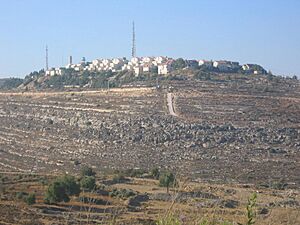
In September 2000, the Second Intifada began. Young people in Ramallah protested daily against the Israeli army. There were marches to checkpoints. Sometimes, there were attacks. Army checkpoints limited movement in and out of Ramallah.
In 2002, the Israeli army entered Ramallah during Operation Defensive Shield. There were curfews and power cuts. Many government offices were damaged. Life became very difficult. Many people left the city. The building of the Israeli West Bank barrier also made Ramallah more isolated.
Yasser Arafat made the Mukataa in Ramallah his headquarters. Ramallah became the unofficial capital of the Palestinian Authority. Most government offices are there.
After Arafat died in 2004, he was buried in the Mukataa courtyard. The site is still the main office for the Palestinian Authority and President Mahmoud Abbas.
In 2005, Janet Mikhail was elected mayor of Ramallah. She was the first woman to hold this position. Some people believe that Ramallah becoming the main center helps Israel avoid making Jerusalem the capital of a Palestinian state.
Geography and Weather
Ramallah has a Mediterranean climate. This means it has dry, hot summers and mild, rainy winters. Sometimes it even snows! The average rainfall in Ramallah is about 615 mm (24 inches) per year.
Economy and Business
Ramallah is the main financial and business center for the Palestinian Authority. Many banks and financial groups are located here. It's also where most international non-profit organizations and embassies have their offices.
A lot of money from international aid has helped Ramallah's economy grow a lot since the Second Intifada. This strong economy attracts Palestinians from other towns where jobs are harder to find. The city has grown five times larger since 2002.
There's a big construction boom in Ramallah. The economy is growing at about 8% each year. This is thanks to more stability and support from other countries. The Palestine Investment Fund is building a huge $400 million business center. It will have 13 towers, some of the tallest in Ramallah.
Ramallah also has the most high-tech companies in the area. ASAL Technologies, an IT company, has 120 employees and is growing fast. There's a new tech park called the India Palestine Techno Park. Even Apple Inc. has a research center in Rawabi, working with ASAL Technologies. Many international companies hire Palestinians in Ramallah.
By 2010, Ramallah was the top spot for business and politics in areas controlled by the Palestinian Authority. Many new apartment buildings and hotels were built. Over 100 Palestinian businesses moved to Ramallah from East Jerusalem. This is because taxes are lower and there are more customers. People often say Ramallah is becoming the unofficial capital of Palestine.
People and Population
In 1870, Ramallah had about 635 men living in 249 houses. By 1896, the total population was around 2,061 people.
In 1922, under British rule, Ramallah had 3,104 people. Most were Christians (2,972), with 125 Muslims and 7 Jews. By 1931, the population grew to 4,286. Most were still Christians (3,766), with 519 Muslims and 1 Jew. In 1945, the population was 5,080, with Christians still being the majority (4,440 Christians and 640 Muslims).
However, between 1948 and 1967, many Christians left the city. By 1967, about half of the city's 12,134 people were Christian, and the other half were Muslim.
Ramallah's population dropped in the late 1900s. In 1997, it was 17,851. Over 60% of these people were Palestinian refugees. About 45.9% of the population was under 20 years old.
By 2005, the population was over 24,000. In 2007, there were 27,460 people living in the city. Today, about 25% of the population is Christian.
Places of Worship
The Jamal Abdel Nasser Mosque is one of the biggest mosques in Ramallah.
There are many Christian churches in the city:
- The Orthodox Church of Ramallah (an Orthodox Christian convent)
- Melkite Catholic Church
- Evangelical Lutheran Church
- Arab Episcopal (Anglican) Church
- Ramallah Local Church (Evangelical)
- Ramallah Baptist Church
A large new church belonging to the Coptic Orthodox Church has been built on a high hill. There are also a small group of Jehovah Witnesses in the area.
-
A Coptic church
During the annual "Saturday of Light" festival, scouts hold a parade. They receive a special flame from Jerusalem. This flame is lit in Jerusalem's Church of the Holy Sepulchre. It is then passed to churches in the region using candles and lanterns.
Culture and Fun
Ramallah is known as the most modern and lively Palestinian city. Many famous Palestinian activists, poets, artists, and musicians live here. It has a great nightlife with many restaurants, cafes, and clubs.
One special treat in Ramallah is Rukab's Ice Cream. It's made with chewing gum resin, giving it a unique taste. The First Ramallah Group is a popular scout club. They perform traditional dances called Dabka. They also have basketball teams. Famous musicians and dance groups sometimes visit Ramallah. The well-known pianist Daniel Barenboim often performs here.
The Khalil Sakakini Cultural Center, opened in 1996, is a popular place for events. The Al-Kasaba Theatre shows plays and movies. In 2004, the modern Ramallah Cultural Palace opened. It has a large auditorium, conference rooms, and movie screens. Ramallah also held its first international film festival in 2004.
-
Kebab stand in Ramallah
-
Monument and Palestinian flag at Al Sa’a Square/Yasser Arafat Square
Ramallah's Traditional Culture
Ramallah, like other Palestinian areas, has a rich tradition of songs and dances. Songs were sung for every occasion, from harvests to weddings. Most songs were sung by women, except for Zaffeh and Mal'ab, which men sang at weddings. A book called "Ramallah Folklore Songs and Traditions" by Bahia Khalil records many of these old songs.
Palestinian Clothing Styles
Travelers in the late 1800s and early 1900s often noticed the many different clothing styles in Palestine. Especially among village women, their clothes could tell you a lot. Before the 1940s, most Palestinian women could tell a lot about another woman just by looking at her dress. They could tell if she was married or single, and which town or area she was from. This was shown by the type of fabric, colors, cut, and embroidery on her "thoub" (a robe-like dress).
Experts believe Palestinian costumes have ancient roots. However, no actual clothing from very early times has survived. Influences from different empires that ruled Palestine, like Ancient Egypt and Ancient Rome, can be seen in old art and writings.
Hanan Munayyer, who collects and studies Palestinian clothing, sees early Palestinian clothing styles in art from 1500 BCE. She says that from 1200 BC to AD 1940, all Palestinian dresses were made from natural fabrics. They had a similar A-line shape with triangular sleeves. This style is known as the "Syrian tunic."
Because travel was hard in the 1800s, villages in Palestine were quite isolated. So, clothing and accessories became a way to show where you were from. In Ramallah, the back of dresses often had a palm tree design sewn in cross-stitch. Ramallah women were famous for their special white linen dresses with red silk embroidery. The headdress, or smadeh, worn in Ramallah was common in northern Palestine. It was a small, round cap with gold and silver coins hanging down. A long veil was pinned to the back.
-
Young woman of Ramallah wearing dowry headdress, c. 1898–1914 (American Colony Collection)
-
A man from Ramallah spinning wool. Hand tinted photograph from 1919, restored (American Colony Collection)
Ramallah and the World
Many countries have their diplomatic offices for the Palestinian Authority in Ramallah. As of 2010, these included Argentina, Australia, Austria, South Korea, South Africa, Norway, Switzerland, China, Poland, Portugal, the Netherlands, Russia, Jordan, Brazil, Finland, Denmark, Ireland, Germany, India, Japan, the Czech Republic, Canada, and Mexico.
Sister Cities
Ramallah has "sister city" relationships with several cities around the world. This means they share cultural and educational ties.
 Bordeaux, France
Bordeaux, France Hounslow, England, United Kingdom
Hounslow, England, United Kingdom Johannesburg, South Africa
Johannesburg, South Africa Liège, Belgium
Liège, Belgium Muscatine, Iowa, United States
Muscatine, Iowa, United States Oxford, England, United Kingdom
Oxford, England, United Kingdom Sur, Turkey
Sur, Turkey Trondheim, Norway
Trondheim, Norway Dublin, Ireland
Dublin, Ireland
Famous People from Ramallah
- Paul Ajlouny (born 1933), a Palestinian-American publisher and businessman.
- Mahmoud Eid (born 1993), a professional football player.
- Jibril Rajoub (born 1953), a Palestinian political leader.
- Mosab Hassan Yousef (born 1978), a Palestinian former militant.
See also
 In Spanish: Ramala para niños
In Spanish: Ramala para niños



